| Srl | Item |
| 1 |
ID:
097938
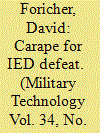

|
|
|
| 2 |
ID:
147135
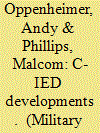

|
|
|
| 3 |
ID:
142280
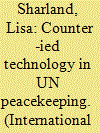

|
|
|
|
|
| Summary/Abstract |
Improvised explosive devices (IEDs) pose a significant threat to UN peacekeepers. This article argues that the UN needs to draw on the lessons from multinational engagements such as Afghanistan to identify, generate and deploy counter-IED technology to UN peacekeeping operations in a more systematic manner. It examines lessons emerging from the application of counter-IED technology in past multinational operations in order to identify areas to expand capabilities and mitigate risks in addressing the threat in the context of UN peacekeeping operations. First, it examines the evolving nature of the IED threat. Second, it surveys some of the lessons emerging from the use of technology in multinational engagements such as the NATO International Security Assistance Force in Afghanistan. Third, it explains some of the approaches already in place in UN peacekeeping operations. Fourth, it identifies potential challenges and limitations to employing more technology solutions to counter IEDs in UN peacekeeping missions, offering some thoughts on areas requiring broader reform to address the growing IED threat in UN peacekeeping missions. It concludes that technology can improve force protection, intelligence and the medical support available to peacekeeping missions to prevent and mitigate the effect of IEDs, thereby strengthening the safety and security of peacekeeping personnel, enhancing mission mobility, and improving the effectiveness of mandate implementation when it comes to the protection of civilians and early peacebuilding efforts.
|
|
|
|
|
|
|
|
|
|
|
|
|
|
|
|
| 4 |
ID:
106001
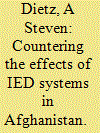

|
|
|
|
|
| Publication |
2011.
|
| Summary/Abstract |
The current approach to countering the threat of improvised explosive devices (IEDs) in Afghanistan has met with limited success. The relative lack of success may be in part because the current approach is not holistic and discounts the social systems that foster the IEDs. Insurgents are using IEDs as a tool to further their strategic aims, but the coalition and to a lesser extent the Government of the Islamic Republic of Afghanistan (GIRoA) are attacking the IEDs as if they are an end in and of themselves. Combining network disruption with information change maximizes the opportunities for mitigating the IED threat. More specifically, to mitigate the IED threat requires disrupting the social and economic systems associated with IEDs, and at the same time providing alternative economic opportunities and improving rule of law and governance at the local level. In other words, counter-IED (C-IED) must be Counter-Insurgency (COIN) centric to be successful. This paper reviews the current state of C-IED efforts, identifies five main problems with the current approach, and suggests changes to reduce or mitigate the IED threat in Afghanistan.
|
|
|
|
|
|
|
|
|
|
|
|
|
|
|
|
| 5 |
ID:
105384


|
|
|
| 6 |
ID:
123863
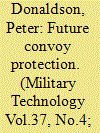

|
|
|
|
|
| Publication |
2013.
|
| Summary/Abstract |
In this article, the author discusses the importance of convoy protection. The convoy protection includes improvements to vehicles, equipment and techniques. The technology includes gunfire/sniper detection which can indicate the source of incoming projectiles and cue remote and manned weapon stations. Also discussed is the convoy protection device RHINO from the U.S. military which uses a heat source to prematurely detonate passive infrared triggered improvised explosive device.
|
|
|
|
|
|
|
|
|
|
|
|
|
|
|
|
| 7 |
ID:
118451
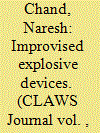

|
|
|
| 8 |
ID:
073038
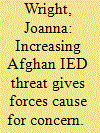

|
|
|
| 9 |
ID:
150566


|
|
|
|
|
| Summary/Abstract |
IED attacks in Afghanistan went from 797 attacks in 2006 to 15,222 attacks in 2012. In that time, 53,997 IEDs and their human collaborators injured more than 11,416 US soldiers and killed over 1,298 soldiers in Afghanistan. If you include Iraq, IEDs account for almost two-thirds of all US soldiers wounded and killed in both wars. This article investigates why something as low-tech as an improvised bomb is so significant to contemporary warfare. The article contends that, contrary to the effort to “beat” the IED by the US Department of Defense, the IED is not a thing. The IED, I argue, is a condition of possibility present in almost all of contemporary life. IEDs are native inhabitants of a world of global relations and things that hover on the edge between tool and weapon.
|
|
|
|
|
|
|
|
|
|
|
|
|
|
|
|
| 10 |
ID:
065020
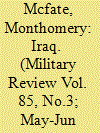

|
|
|
|
|
| Publication |
May-Jun 2005.
|
|
|
|
|
|
|
|
|
|
|
|
|
|
|
|
| 11 |
ID:
123913
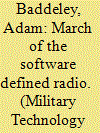

|
|
|
|
|
| Publication |
2013.
|
| Summary/Abstract |
In this article, the author discusses the software defined radio (SDR) technology. SDR provides a platform to allow militaries to keep adding things to new waveforms and other radio frequency functions like electronic attack, signals intelligence and counter improvised explosive device jamming. Also discussed is the military programme SVFuA SDR from Germany which is to replace the legacy SEM family of radios. INSET: RUAG Defence: Tactical Telephony
|
|
|
|
|
|
|
|
|
|
|
|
|
|
|
|
| 12 |
ID:
153967


|
|
|
| 13 |
ID:
190965
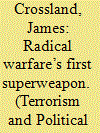

|
|
|
|
|
| Summary/Abstract |
This article retraces the forgotten legacy of a percussion triggered shrapnel scattering improvised explosive device (IED), known as the Orsini Bomb. Initially used in an attempt to assassinate Emperor Napoleon III in 1858, in the decades after, the Orsini Bomb was replicated, modified and deployed by regicides, insurgents and terrorists, and mythologised by the press as an omnipresent aspect of such forms of radical warfare. This article presents a “biography” of this unique IED, concluding, firstly, that Orsini’s design was an important point of reference in weapons manufacture for violent radicals even after the advent of dynamite in the 1860s and, secondly, that its reputation as a semiotic reference point for terrorist activity was enhanced by press reportage of its proliferation and use throughout the fin de siècle. In the final analysis, the Orsini Bomb became a transnationally recognised “brand” of weapon, synonymous with both assassination and insurgency. As such, the bomb’s reputation—often dwarfed in the historiography of political violence by dynamite—needs to be reconsidered.
|
|
|
|
|
|
|
|
|
|
|
|
|
|
|
|
| 14 |
ID:
123870


|
|
|
|
|
| Publication |
2013.
|
| Summary/Abstract |
In this article, the author discusses the radio-controlled improvised explosive devices (RCIEDs). Working of an RCIED includes transmission of a radio signal to a receiver within the improvised explosive device (IED). According to him, deployment of radio-frequency jammers as electronic countermeasures (ECM) to RCIEDs can protect convoy missions, high-profile buildings and border crossing checkpoints. INSETS: Ensuring Both Optimum Protection and Efficient Planning of Furthe;The Devastating EFP.
|
|
|
|
|
|
|
|
|
|
|
|
|
|
|
|